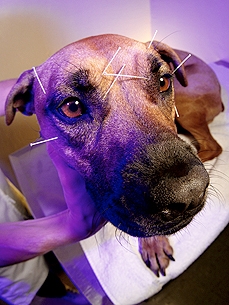
Laser therapy is a cutting edge treatment option for many medical conditions. Around the world, laser therapy is rapidly becoming the choice for pet owners seeking painless, non-invasive, and drug free treatments for a wide variety of injuries, pain, syndromes, neurological conditions and pathologies for their pets. It can heal wounds and fractures up to 60% faster and reduce the cost of treatment for many conditions.
Laser therapy is a natural method of healing that uses specific wavelengths of light to administer accurate measured doses of energy directly to a treatment site. Laser therapy works in several ways to heal injuries and manage pain. It increases the release of endorphins (natural painkillers) and decreases inflammation and nerve conduction which helps return tissue to a normal state.
Laser therapy is used to treat many medical conditions including soft tissue wounds, surgical incisions, ear infections, ulcers, burns, stomatitis (gingivitis) and any type of pain.

Low Level lasers send accurately measured, non-thermal photons of light to the appropriate treatment sight. These light waves supply energy to the body as they penetrate up to 4 inches of the skin's layer's, optimizing the immune responses of the blood. This has anti-inflammatory and immunostimulant effects, supplying vital oxygen and energy to every cell. This enables cells to heal and repair themselves at a greatly accelerated rate.
Laser therapy sessions speed up the healing process in the cells that can help create a stronger and longer lasting effect. Many conditions are permanently resolved after completing laser treatments.







+headshot.jpg)

